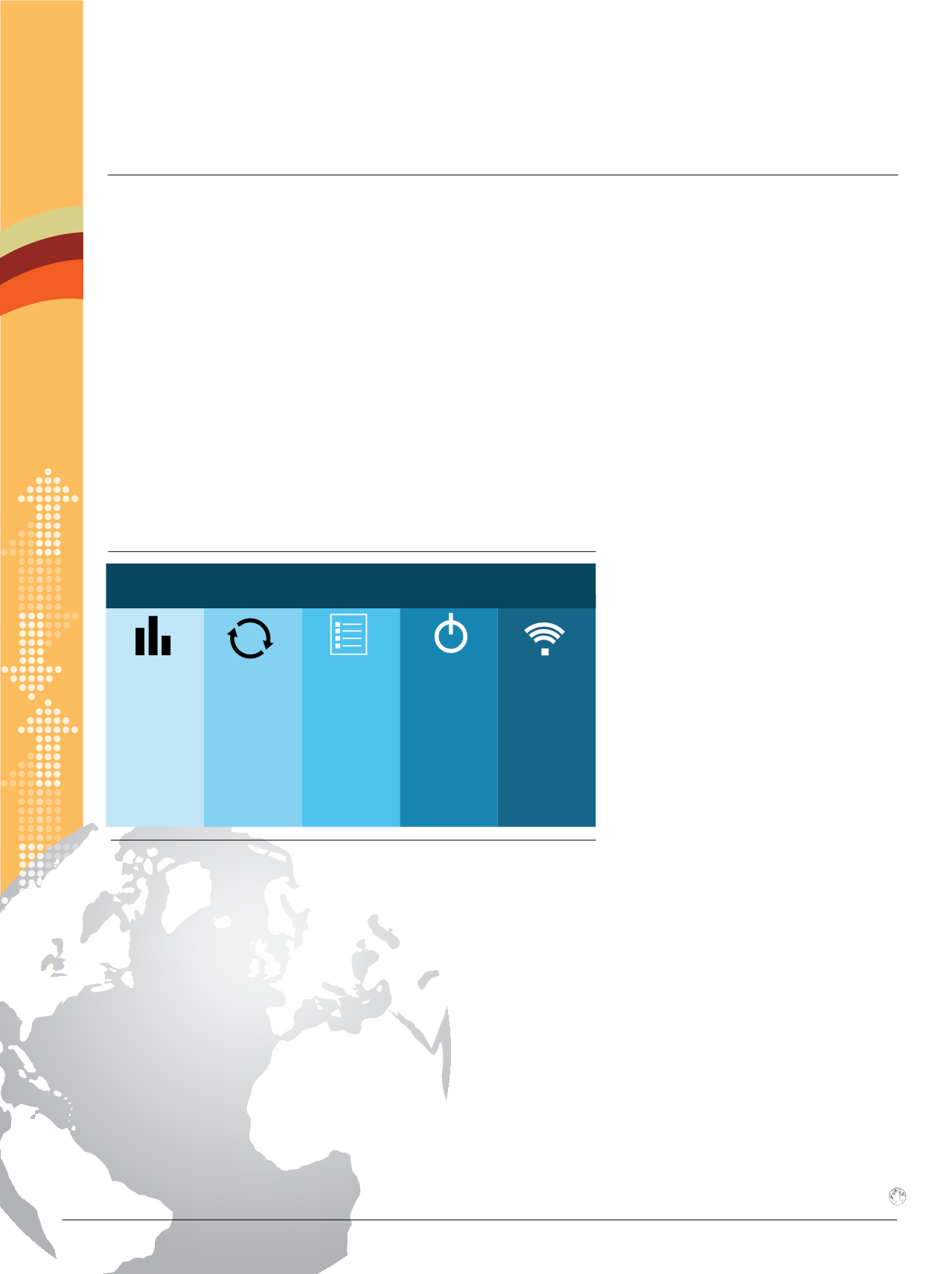

By
Tara
Seals
The Internet of Things (IoT) is
perhaps the most buzzed-about
technology evolution out there at the
moment, and no wonder: during the
past decade, digital technologies have
begun to blanket our lives, forming the
backbone of a large, intelligent infra-
structure that can support, in theory,
billions of new devices with connectiv-
ity to the Internet and to each other.
That means installing a sensor on
everything from home thermostats and
fridges to wind turbines, self-driving
cars and even cattle and wheat fields.
According to Ericsson’s latest Mobility
Report, IoT connections will overtake
phone subscriptions by 2018. And,
overall mobile connections will number
27.5 billion by 2021, with the IoT ac-
counting for 15.7 billion of that total.
By comparison, the number of mobile
phone connections is expected to reach
8.6 billion in that time period. Further, a
recent BI Intelligence report found that
nearly $6 trillion will be spent on IoT
solutions during the next five years.
And indeed, money-making oppor-
tunities associated with IoT are com-
ing into focus for companies across
the channel. Businesses see the ways
the IoT can improve their bottom line
by lowering operating costs, increasing
productivity and expanding market and
product development. A Verizon Wire-
less report this year found that 72 per-
cent of businesses see IoT as “critical
to their competitive advantage.”
CompTIA found that 23 percent
of channel companies surveyed say
they’ve already made money from IoT
offerings, compared to just 8 percent
in 2015. Looking forward, one-third of
channel firms expect to make money
from IoT in the next 12 months.
“The channel is making significant
progress with monetizing the IoT op-
portunity and, unlike past years, view
themselves as strong profitability candi-
dates,” said Seth Robinson, senior direc-
tor of technology analysis at CompTIA.
Three-quarters of channel firms in
the CompTIA survey said they have a
more positive view of IoT today than
they did a year ago. Another 21 per-
cent have not changed their opinion
during the past 12 months, a group
that certainly includes firms that were
bullish on IoT to begin with.
“First, the complexity of IoT proj-
ects is beyond what many companies
can handle internally, especially on the
SMB end of the spectrum,” Robinson
explained. “Second, many areas of IoT
are essentially extensions of the skills
and lines of business that solution
providers already have.”
Consulting is currently the most
popular IoT channel offering, with 40
percent of companies offering some-
thing in this space. The next most pop-
ular offering is security, provided by 36
percent of firms. Analytics, managed
services, custom app development,
reselling, and infrastructure services
are offered by between 30 percent and
35 percent of companies.
Some IT solution providers are carv-
ing out unique niches in the IoT market.
For example, Presidio provides a fleet
management solution for a Texas school
district, allowing administrators to track
student safety and bus routes across
625 square miles. Dimension Data em-
powered the Tour de France with a range
of IoT applications – including custom
network transported sensor information
from bicycles – to deepen fan engage-
ment. Axians helped to develop an in-
building IoT lighting system that enabled
a European energy network company to
slash its energy consumption by up to
70 percent; and Impetus Technologies
created a factory-floor IoT system that
helped a customer improve its manufac-
turing processes and reduce the volume
of product defects.
Much of the early work is being done
in Europe. For instance, Telia Carrier and
Ericsson have signed an agreement that
enables IoT operators to connect via any
of Telia Carrier’s 220 IPX PoPs directly to
Ericsson’s Device Connection Platform in
a single network hop.
Meanwhile, in the Netherlands,
KPN has blanketed the country with
LoRa (long range) wireless access,
with 1.5 million objects hooked up to
the network. Initial projects include
port of Rotterdam depth sounders be-
ing outfitted with sensors and network
connections, a trial to connect all rail-
way switches so they can be monitored
centrally, and tests with baggage track-
ing at Schiphol airport in Amsterdam.
IoT Connects Up
New Channel Opportunities
INTERNATIONAL AGENTS
SECTION
Source: HPE Security
Source: CBRE, eMarketerx
Number of Stores that
Worldwide Plan to Op
Source: 451 Research
Ways Companies Are U
23%
21%
20%
13%
12%
12%
6%
Estimated ROI for seven categories of enabling
security technologies
Source: Ponemon Institute; HPE Security
IT Executive Perceptions of where the Internet of Things will Most Likely
Have an Impact or Provide Value
Source: CompTIA
Security intelligence
systems
Extensive deployment of
encryption technologi s
Advanced perimeter controls
and firewall technologies
Access governance tools
Extensive use of data
loss prevention tools
Enterprise deployment
of GRC tools
Automated policy
management tools
Windows
88%
-2%
Creating new
revenue/business
opportunities from
connected systems
(e.g. smart cities,
connected
vehicles)
Controlling and
monitoring newly
connected pieces
of equipment
Collecting new
streams of data
Adding intelligence
to previously
“dumb” objects or
systems
Gathering
contextual
information
about
customers
Create
42% 53%
46% 46% 35%
Control &
Monitor
Internet of Things Elements
Collect
Intelligence
Context
11-20
23%
40+
17%
21-30
10%
31-40
5%
Security Monitoring
Energy/Lighting
Management
HVAC Management
Remote Asset
Tracking/Management
Collecting Big Data
on Products
Transportation/Delivery
Services Management
Jan 201
In which of the following ways
“Internet of Things” technology
36
CHANNEL
VISION
|
July - August 2016
















